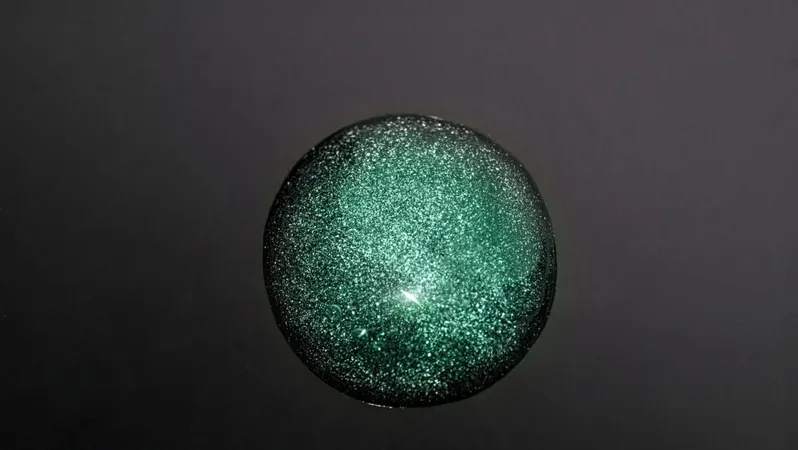
Unveiling 'Dark Oxygen': Earth's Deep Sea's Astonishing Secret at 4,000 Meters Below Sea Level
2025-04-06
Author: Daniel
Introduction
Scientists have made an astonishing discovery 4,000 meters below sea level in the Clarion-Clipperton Zone (CCZ), an abyssal plain located between Hawaii and Mexico, known for its stunning diversity of marine life and vast quantities of polymetallic nodules. These potato-sized rocks, filled with valuable metals like nickel, copper, and cobalt, are crucial for the future of green energy technologies. However, their most unexpected secret is the production of what researchers are calling "dark oxygen," a form of oxygen generated in complete darkness.
A Shift in Understanding
Historically, scientists have understood that the Earth's oxygen supply originated from photosynthetic organisms thriving in sunlight. Yet, this groundbreaking study, published in *Nature Geoscience*, reveals that significant oxygen production can take place in the ocean's depths, where light does not penetrate. This finding challenges conventional wisdom, sparking new questions about the origins of life on our planet and what this might mean for the potential for life on other celestial bodies, like the icy moons Europa and Enceladus.
Research Insights
Andrew Sweetman, a deep-sea ecologist at the Scottish Association for Marine Science and the lead author of the study, remarked, "For aerobic life to begin on the planet, there had to be oxygen. Our understanding has been that Earth's oxygen supply began with photosynthetic organisms. But we now know that there is oxygen produced in the deep sea, where there is no light."
The Discovery Process
The journey to this discovery began over a decade ago when Sweetman first noticed unexpected fluctuations in oxygen levels in the CCZ. Initial assumptions attributed these anomalies to faulty sensor readings. However, as subsequent research established consistent patterns of oxygen production, Sweetman theorized that the minerals in the polymetallic nodules may be acting as "geobatteries," facilitating electrolysis of seawater and enabling oxygen generation.
Laboratory Findings
The research team created laboratory conditions mimicking those found in the CCZ and surprisingly found oxygen levels rising even after killing off any microorganisms. This unusual phenomenon might stem from the natural charge of approximately 0.95 volts detected on the nodules' surfaces, which could catalyze the breakdown of seawater into hydrogen and oxygen.
Implications for Deep-Sea Mining
As the implications of this discovery unfold, it intensifies the ongoing debate surrounding deep-sea mining. Mining companies like The Metals Company view these nodules as a solution to the energy crisis, dubbing them as "batteries in a rock," while at least 25 countries advocate for a moratorium on deep-sea mining. They argue that comprehensive ecological studies are essential to understand the potential impacts of mining on fragile ocean ecosystems already stressed by climate change and pollution.
Ecological Significance
Lisa Levin from the Scripps Institution of Oceanography, who was not involved in the study, emphasized the significance of these newfound oxygen-producing capabilities: "This is an excellent example of what it means to have the deep ocean as a frontier. The production of oxygen at the seafloor by polymetallic nodules is a new ecosystem function that needs to be considered when assessing the impact of deep-sea mining."
Conclusion
As discussions continue within the International Seabed Authority regarding regulations for these valuable resources, the fate of the world’s oceans hangs in the balance. This remarkable new understanding of deep-sea ecosystems reinforces the urgency for conservation over exploitation, as humanity stands at a crossroads—either fostering a sustainable future or risking irreversible damage to our oceans. The ocean's depths hold secrets yet to be discovered, and as scientists push the boundaries of our knowledge, we must tread carefully to protect these vital ecosystems.



 Brasil (PT)
Brasil (PT)
 Canada (EN)
Canada (EN)
 Chile (ES)
Chile (ES)
 Česko (CS)
Česko (CS)
 대한민국 (KO)
대한민국 (KO)
 España (ES)
España (ES)
 France (FR)
France (FR)
 Hong Kong (EN)
Hong Kong (EN)
 Italia (IT)
Italia (IT)
 日本 (JA)
日本 (JA)
 Magyarország (HU)
Magyarország (HU)
 Norge (NO)
Norge (NO)
 Polska (PL)
Polska (PL)
 Schweiz (DE)
Schweiz (DE)
 Singapore (EN)
Singapore (EN)
 Sverige (SV)
Sverige (SV)
 Suomi (FI)
Suomi (FI)
 Türkiye (TR)
Türkiye (TR)
 الإمارات العربية المتحدة (AR)
الإمارات العربية المتحدة (AR)